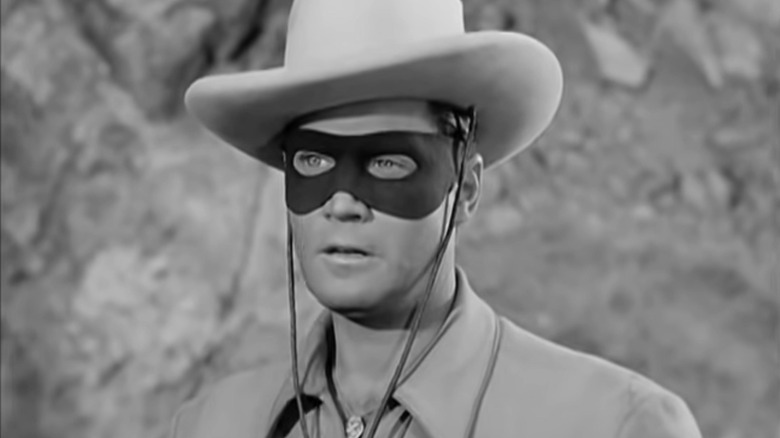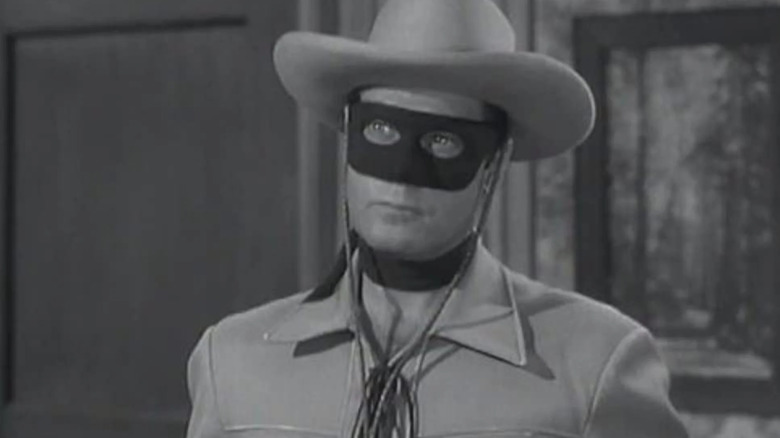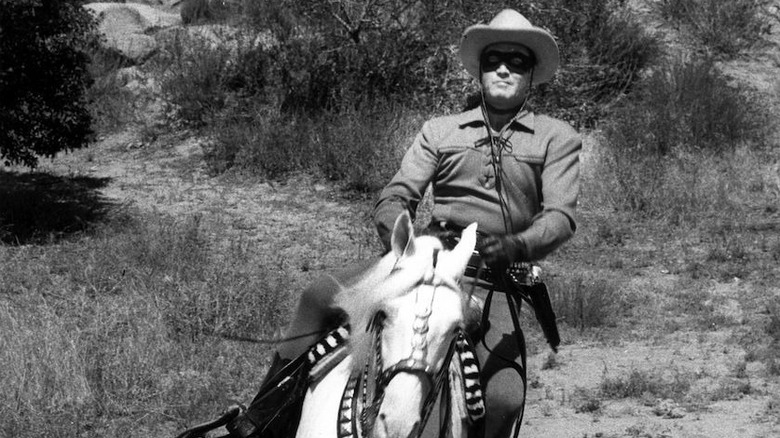The Lone Ranger made his debut on a Detroit radio station in 1933, invented by either the station’s owner, George W. Trendle, or the show’s writer, Fran Striker. (There’s some debate on the matter.) As fans of Westerns will know, The Lone Ranger was a masked vigilante who operated in the wilds of 19th century America, tracking down criminals with his best friend, a man named Tonto. Tonto’s origins were never made wholly clear, although he’s most likely Apache, Comanche, or Potawatomi. The Lone Ranger rode a horse named Silver, and used silver bullets to dispatch his victims.
The Lone Ranger’s origin story is the stuff of comic book lore. The Ranger’s older brother and a posse of other Texas Rangers were on the trail of an evil criminal named Cavendish, when, thanks to a betrayal, Cavendish got the drop on them. Cavendish killed them all, but left a young boy alive. The young boy is nursed back to health by Tonto, and he fashions a mask out of his dead brother’s vest. Thereafter, he becomes obsessed with justice.
In 1949, “The Lone Ranger” TV series debuted, and it was incredibly popular, lasting 221 episodes over its five seasons before finally getting canceled in 1957. Jay Silverheels played Tonto and Clayton Moore played the Lone Ranger in the TV series, with an actor named John Hart stepping into the title role from 1952 to 1953. Clayton Moore came back in 1953 and ran out the show’s tenure. He was one of TV original pulp heroes. Like many of the best Westerns ever, the show was loved, if not always acclaimed.
But why did Clayton Moore step away from the role? All the online sources say that Moore left “The Lone Ranger” due to a contract dispute, and that has become the generally accepted knowledge. It seems, though, that the lead actor swap for “The Lone Ranger” is a little more nuanced and mysterious than that. Indeed, looking at Moore’s 1999 New York Times obituary, he claimed ignorance as to why he was fired for a year.
John Hart replaced Clayton Moore as the Lone Ranger from 1952 to 1953 … but the reasons remain vague
So where did the “contract dispute” rumor get started? Possibly in a nostalgic retrospective printed in The Los Angeles Times back in 1993. The L.A. Times piece noted that, yes, John Hart was the Lone Ranger for the show’s 1952 to 1953 season, and Hart was quoted as saying how happy he was to have taken part, even if it was only for a year. It also added, in a mere parenthetical, that Clayton Moore was out of “The Lone Ranger” because of a contract dispute. The nature of the dispute is not explained, and no elucidation is given. If one looks up Clayton Moore on online information sources like Wikipedia, the “contract dispute” explanation remains in place.
20 years after Moore’s death, in 2019, the South Bend Tribune finally tried to settle the matter, as the lack of information on this supposed dispute has left fans frustrated for decades. The fact that Clayton Moore doesn’t recall a dispute is the main reason to remain suspicious. What really happened back in 1952?
It seems one reason for Moore’s firing was not a contract dispute, exactly, but it was about money. Moore’s daughter, Dawn, sat for a video interview (sadly, now deleted) that the Tribune quotes, and she explained the merch situation. It seems that Moore caught wind of how much money the studio was making with “Lone Ranger” merchandise, and wanted a cut. Kids of the 1950s will confirm that “The Lone Ranger” was a merch bonanza, with masks, toy guns, and action figures made widely available.
Rather than give Moore a cut of merch sales, George W. Trendle, who also ran the TV series, fired the actor and hired Hart in his place. Trendle apparently felt that the Lone Ranger’s domino mask obscured his lead actor’s face enough that any “Lone Ranger” actors would be interchangeable. Trendle thought nothing of cutting his show’s biggest star over a cut of the merch.
But maybe that Lone Ranger story’s not true, either
Dawn, however, felt that this story may not be true, as she knew her father well, and felt that he wasn’t business-savvy enough — or was simply too polite — to ask for a cut of the “Lone Ranger” merch sales. Regardless, Trendle’s scheme didn’t work, as Hart wasn’t as well-received as Clayton Moore. Hart was canned in 1953 and Moore was brought back. There is no record that can be easily found as to whether or not Moore was able to get any merch money, or if he got a raise to return. Given common practices in television, however, it’s wholly likely that some kind of increased financial incentive was involved.
Since the TV series ended, the Lone Ranger has popped up periodically throughout popular culture. Moore and Silverheels starred in two “Lone Ranger” feature films in 1956 and 1958, and there was an animated series put out by CBS in 1966. Filmation made a second animated series in 1980 in which the Lone Ranger was paired with Tarzan, and William A. Fraker made a slick (and very unsuccessful) feature film in 1981 called “The Legend of the Lone Ranger.” Klinton Spillebury play the Lone Ranger in that version.
Audiences also likely remember the very expensive 2013 film “The Lone Ranger” film by Gore Verbinski, starring Armie Hammer. That film was an even bigger bomb than the 1981 film, and is on the books as one of the biggest money-losing films of all time. Whether or not Hollywood will ever try again remains to be seen.











